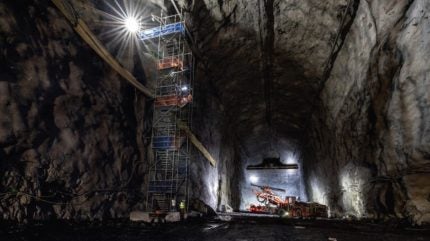
Excavation has been completed on three large caverns in South Dakota that are to hold the massive particle detectors for the international Deep Underground Neutrino Experiment (DUNE).
Work to create the caverns began in 2021 and the excavation removed nearly 800,000 tonnes of rock.
Hosted by the US Department of Energy’s (DOE) Fermi National Accelerator Laboratory (Fermilab), DUNE scientists will use large equipment installed in the caverns to study neutrino particles.
The rock caverns, which are located 1600m below the surface at the Sanford Underground Research Facility, will provide space for four large neutrino detectors – each one about the size of a seven-storey building.
The detectors will be filled with liquid argon and record the rare interaction of neutrinos with the transparent liquid.
Scientists will look for neutrinos from exploding stars that research Earth, and also be examining the behaviour of a beam of neutrinos produced at Fermilab. From there the beam will travel straight through earth and rock to the DUNE detectors housed in the caverns in South Dakota.
“The completion of the excavation of these enormous caverns is a significant achievement for this project,” said US project director Chris Mossey. “Completing this allows the project to begin detector installation later this year.”
Workers will shortly start the fit-out phase of the major project with installation of the systems needed for the DUNE detectors and the daily operations of the research facility. Later this year, the project team plans to begin the installation of the insulated steel structure that will hold the first neutrino detector. The goal is to have the first detector operational before the end of 2028.
“The completion of the three large caverns and all of the interconnecting drifts marks the end of a really big dig. The excavation contractor maintained an exemplary safety record working over a million hours without a lost-time accident. That’s a major achievement in this heavy construction industry,” said Fermilab’s Michael Gemelli, who managed the excavation of the caverns by Thyssen Mining. “The success of this phase of the project can be attributed to the safe, dedicated work of the excavation workers, the multi-disciplined backgrounds of the project engineers and support personnel.”



